|
|
FLORIS JESPERS (Belgian, 1889-1965)
|
|
An African Group
oil on canvas
87x 105.5 cm(34 1/4 x 41 9/16 in)
EXHIBITED:
London, Tate Britain, Seeing Africa, July 2006 |
| |
|
|
After World War I, Floris Jespers energetically took part in the modernist movement of the young Antwerp artists. In the 1920s he became a virtuoso in the difficult technique of painting under glass. An established and successful artist, Floris was flooded by official orders between 1952 and 1958 and was repeatedly sent to the Congo. He returned with a unique style, far from the Africanism of an amateur ethnologist. Under the shadeless sun of the equator, Jespers selects a vegetable
pallet; the brown of the figures, the beige of the ground, clothing and trees. He is in love with the African woman.
He expresses this in his own words: ”I am at this moment living in a small, humble village in Katanga, just a few trees and some sliding shadows of women going home and carrying on their mysticism in infinite silence and solemnity. They walk in succession, like floating swans, up to their ‘Cite Indigene’ a world of beauty and mystery. I am not interested in seeing nor knowing which tribe has a flatter nose, more prominent cheek bones or thinner or thicker lips. It is the infinite mystery, the compassionate erotic eyes and the movements that make them all so pretty. So, in my new work I eliminate every detail – everything that could be surplus, a picture to the Congo – I want to only put the abstract, for which you need to know much and to have seen much, before you can express it.”
For Jespers, women were the spirit of Africa. He painted them in different styles, from the stylized realism to the rhythmic, angular forms – where intersecting lines form a coloured mosaic. |
| |
|
|
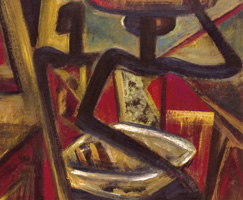 |
|
Two women in abstract
oil on board
45x53.5 cm (17 11/16 x 21 1/16 in).
EXHIBITED:
London, Tate Britain, Seeing Africa, July 2006 |
| |
|
|
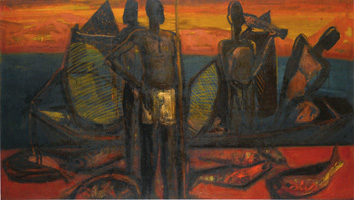 |
|
Fisherman
oil on board
122 x 214cm (48 1/16 x 84 1/4in).
PROVENANCE:
Purchased from the artist
A private collection
EXHIBITED
Oostende, Museum voor Moderne Kunst Oostende, Floris Jespers: Retrospective, December 2004 |
| |
|
|
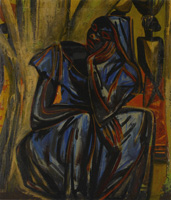 |
|
Femme noble
oil on canvas
78.5 x 68cm (30 7/8 x 26 3/4in).
EXHIBITED:
Oostende, Museum voor Moderne Kunst Oostende, Floris Jespers:
Retrospective, December 2004
LITERATURE:
Jacqueline Guisset, Le Congo et IArt Beige (Tournai 2003) |
| |
|
|
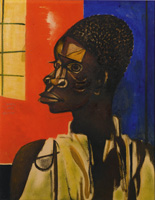 |
|
Portrait of a man, Kamina
signed, inscribed and dated 'Jespers/Kamina/1951 ' (lower leh)
gouache
50x38 cm (19 11/16 x 14 15/16 in). |
| |
|
|
 |
|
Three women
signed and dated 'Jesper 58' (lower right)
oil on canvas
87 x 700.5 cm (31 7/8 x 39 9/16 in).
EXHIBITED:
London, Tate Britain, Seeing Africa, July 2006 |
| |
|
|
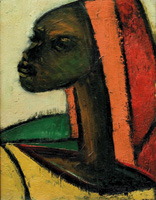 |
|
Portrait of an African princess
oil on canvas laid to board
38.5 x 29 cm (15 3/16 x 11 7/16 in).
EXHIBITED:
London, Tate Britain, Seeing Africa, July 2006
"For Jespers, women were the spirit of Africa. He painted them in different styles, from the stylized realism to the rhythmic, angular forms where intersecting lines form a coloured mosaic."
Bibliography:
Seeing Africa exhibition catalogue |
| |
|
|
| Need image |
|
Marche Africain au tour d'un arbre blanc
signed and dated 'Jespers 53 (lower right); extensively inscribed (verso)
oil on board
133.5 x 260 cm (52 9/16 x 102 3/8 in).
The present work is painted on the inside of a crate used to ship other pictures and is a prime example of Jespers' large-scale work
PROVENANCE:
Purchased from the artist
A private collection
EXHIBITED:
Oostende, Museum voor Moderne Kunst Oostende, Floris Jespers: Retrospective, December 2004 |
| |
|
|
"I am (at this moment) living in a small, humble village in Katanga - just a few trees and some sliding shadows of women going home and carrying their mysticism in infinite silence and solemnity. They walk in succession, floating swans alike, up to their 'Cite Indigene' (indigenous quarter) - A world of beauty - of mystery.
I am not interested in seeing or knowing which tribe has a flatter nose, more prominent cheek bones or thinner or thicker lips.
It is the infinite mystery, the compassionate erotic eyes and the movements that make them all so pretty. So, in my new work I eliminate every detail- everything that could be surplus, 'a picture of 'the' Congo' - I want to only put the abstract, for which you need to know much and to have seen much, very much, before you can express it.
Whether this art will get across, here, is still a puzzle. But I can say: it smells of the jungle, of the tropical world mystery - of the tremendous solemnity - and of the rhythm, which a painter-photographer cannot discover, but a painter-poet and musician can ..
One forgets the odour of the palm oil and other things which the colonials so much talk about. These black people... Their eyes reveal a feeling of childish goodness - and sometimes fear - a fear for the white man - and also a slyness that can frighten you. But with the women there is always the problem of the woman, the inscrutable woman and the mystery one can read in their eyes.
That elegance - their shapes, shoulders, arms and hands, at each movement a dream of grace and rhythm against the blue sky and the vivid red soil - and the green, green leafage. It is ineffable.
I should have discovered this twenty years ago, I say - Yes, - but then I wouldn't have looked with these eyes, eyes full of experience and knowledge.
I continue fighting, as I have always done, for the beauty of creation and for an admiration for exactly that, which one can not hold or get, but which one should possess: to desire to be a painter by God's grace - a vibrating instrument - and then, one feels wearing out, in those moments one lives too fast - too intense - but what an opulence opulence of lines, colours, feeling. It is necessary then, when I come home in the evening, to thumb through the letters of Van Gogh. How clear they are to me - as if I wrote it myself... So, I experienced everything myself, - because it has to be so and cannot be otherwise. Everyday here I live with new discoveries, - and I remember my young years as a child, when my mother took me along to the light parades in town. The fantasy the good Antwerp people had at that time, stuck in my mind: the light of the parade arriving - the music - the horses and the fearful feeling as a small child - so frightened that its little teeth chattered! I still remember this. -And then the splendour of the passing illuminated floats l
In this mood, even with chattering teeth - now, I live new things every minute, which the people here do not see: all this mystery, the clouds, the shining sky, - the forest fire in the jungle - the yellow gold coloured wrapa, the deep eyes of very beautiful people - and lines, as if they had been drawn with a compass.
This is all an overabundance I have never seen. -And I am only at a beginning... How clearly I understand now Gauguin could not stay in Paris... "
Floris Jespers, in a letter dated' 1954 |
.
|